Repair and maintenance manuals for German motorcycles BMW F-series
See this section in russian language
This section contains detailed instructions for self-repair and maintenance of German touring enduro motorcycles called "BMW F650GS", produced from 2000 to 2007.
Description and history of German motorcycles BMW F-series
| F650 Series: | F650 F650ST F650RR F650GS (1-cyl.) F650GS Dakar F650CS |
| F800 Series: | F800S F800ST F800 Sport F800GS F650GS (2-cyl.) F800R F700GS F800GT F750GS F850GS F900R |
In 1989, BMW made the decision to develop motorcycles for the "entry-level" market. The K 75 models were the lightest, but had become so expensive that they were unaffordable for beginner motorcyclists. To keep the price low, they decided not to develop their own engine, but to seek collaboration with another manufacturer. Contacts with Aprilia were positive, but in reality, Aprilia was interested in BMW engines to produce heavier motorcycles themselves. The Aprilia Pegaso 650 had exactly the engine that BMW needed, leading to the start of "Project E169" in 1990. In the winter of 1991, it was decided that Rotax, the supplier of Aprilia engines, would also produce them for BMW, with production taking place at the Aprilia factory. To ensure smooth operations, BMW placed personnel in both factories. The design was taken on by BMW itself. Various designers presented their ideas, with the design by British designer Martin Longmore being chosen. He had also worked on the designs of the K 100 RS and K 1100 RS. In early 1992, a full-size model was built at Aprilia, while Showa was tasked with developing a front fork. Pirelli and Metzeler provided the semi-off-road tires, and Brembo supplied the disc brakes all around.
The engine was not simply taken over. BMW modified the five-valve head to a four-valve head with dual overhead camshafts, replaced roller bearings with plain bearings, swapped the valve cover gasket for a rubber one (for better sound insulation), and replaced the Morse chain for camshaft drive with a roller chain.
By the end of 1993, machines were built consisting of 80 to 95% original parts, and the first tests were carried out. In the summer of 1993, the first series production began. This pre-series of 40 motorcycles underwent further testing, and in September 1993, the BMW F 650 was displayed at the IAA in Frankfurt. To emphasize the "fun factor," the name "Fun Bike" had been suggested, but because the F 650 was an all-road bike, a combination of "Fun" and "enduro" was devised: Funduro. This became the nickname given by BMW to the motorcycle itself, but not the official model designation.
BMW F 650 Series (1993-2007)
Among BMW riders, there was some criticism of the F 650 due to the absence of typical BMW features such as shaft drive and the fact that the machine was not developed or even built in-house. However, BMW riders were not the target audience for these motorcycles. Shaft drive would have significantly increased the price and would have been too heavy for a machine that needed to be lightweight. The transverse engine layout was also less suited for shaft drive, as it would have required a right-angle transmission in the drive. By using chain drive, the Aprilia Pegaso frame could be taken over with minimal changes. From 1999, when the GS models were introduced, production was moved to the BMW factory in Berlin. When the series was mechanically upgraded in 2004, a new luggage rack appeared, allowing a top case to be mounted directly, and the front section was modified.
Engine
The Rotax engine was significantly modified by BMW to increase reliability, extend maintenance intervals, and meet environmental requirements for years to come. It was a liquid-cooled upright single-cylinder four-stroke engine with dual overhead camshafts and four valves. The crankshaft and connecting rod ran on plain bearings. A dry sump lubrication system was used. This engine delivered 48 hp at 6,500 rpm, with maximum torque of 57 Nm at 5,200 rpm. A dry multi-plate clutch was used, and the engine had five gears. In 2004, the F 650 engine was upgraded with a new engine management system and Twin Spark cylinder heads.
Chassis
The F 650 had a semi-double cradle frame with a central top tube serving as an oil reservoir. The machine had chain drive, a departure from the typical BMW single-sided swingarm suspension. The F 650 featured a standard swingarm rear fork and a non-adjustable telescopic fork. A single damper element (monoshock) was placed at the rear, working via a link system. Spring preload and damping were adjustable. The tires were supplied by Pirelli, with traditional spoked wheels used, rather than the cross-spokes suitable for tubeless tires. The wheelbase was 1480 mm, the head angle was 62°, and the trail was 110 mm.
Equipment
For BMW standards, the F 650 was particularly sparsely equipped. This was necessary to keep the price as low as possible. The F 650 had no luggage options at all: a top case had to be purchased separately. This also applied to the center stand, which was not included as standard.
Modifications
The modifications made over the years were minimal and rarely necessary to correct design flaws. In 1995, an unregulated catalytic converter was standard. This had been available as an accessory from the beginning. The steering head bearing was encapsulated to protect it from rainwater. From 1996, the center stand was included as standard. More color options also became available.
F 650 (1993-2000)
The F 650 featured some optical "niceties," such as the tiny windshield, which was clearly not meant to protect the rider from the elements, and the plastic bracket around the rear wheel. This bracket served a purpose: it was a legal requirement to shield the rear wheel, avoiding the need for a large and unsightly mudguard. A plastic protective cover was placed under the engine to emphasize the "all-road" character. The tank seamlessly transitioned into a top half fairing, a design typical of Dakar machines. The F 650 was introduced in 1993, with a "bare" price of FL 13,950 in the Netherlands. Despite its all-road appearance, the F 650 excelled on asphalt.
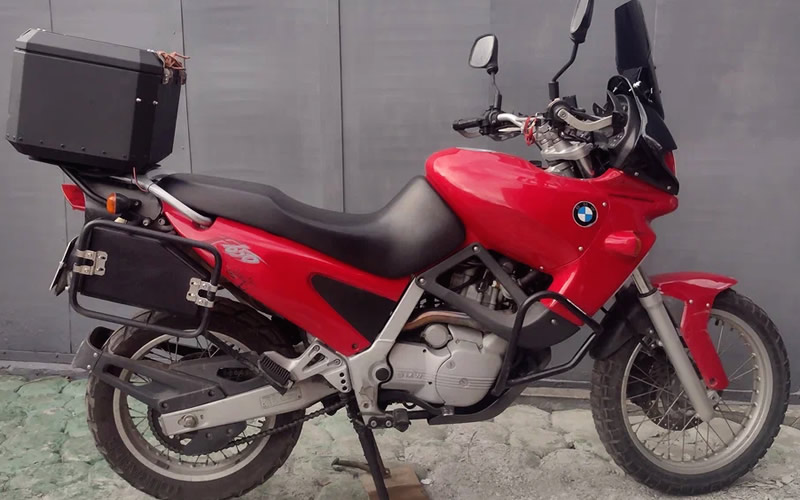
F650 1999 year, right view
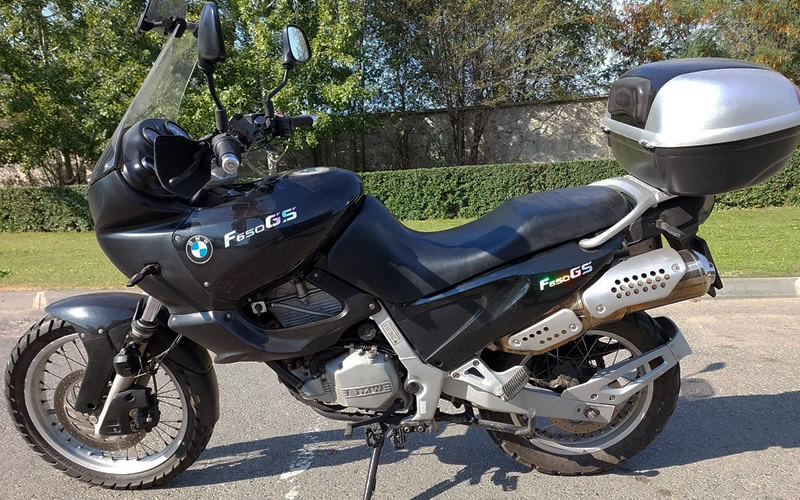
F650 1998 year, left view
F 650 ST (1996-2000)
The F 650 ST (Strada) was released in 1997 as a true street model, though its appearance did not differ much from the original F 650. It featured a slightly taller windshield and rode on standard road tires. The seat height was slightly lower, partly due to the slightly smaller front wheel. A clock was installed in the fairing.
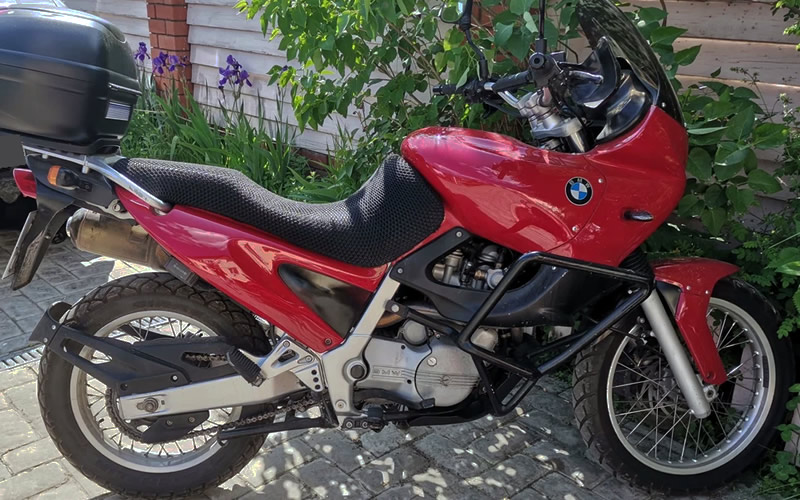
F650ST 1997 year, right view
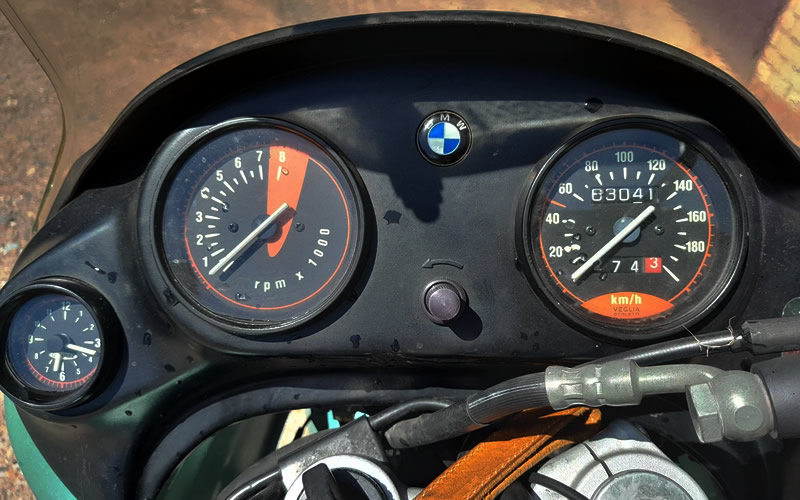
F650ST 2000 year, dashboard
F 650 RR (1999)
BMW had last participated in the Dakar Rally with a factory team in 1986, using heavy boxer engines. From 1999, only single-cylinder engines were allowed to compete in the rally, making the F 650 an excellent candidate. The machine was tuned to around 80 hp, and the first team in 1998 consisted of Edi Orioli, Oscar Gallardo, and Jean Brucy. Andrea Mayer competed in the Ladies Cup. The bike was equipped with three fuel tanks holding a total of 54 liters of gasoline and featured onboard GPS. Richard Sainct won the rally with BMW in 1999 and 2000.
F 650 GS (2000-2007)
The F 650 GS was introduced in 2000, effectively succeeding the F 650, which was discontinued a year later. The GS underwent significant technical changes compared to its predecessor. The fuel tank was now located under the seat, with the fuel cap on the right rear of the motorcycle. A high front fender was installed, giving the appearance of a more off-road-oriented bike. This fender featured the "beak" shape characteristic of the R 1100 GS. The engine also delivered slightly more power: 50 hp instead of 48. The bike now featured fuel injection, a catalytic converter, and an airbox, which, along with the battery, occupied the former tank location. An anti-lock braking system was available as an option. From 2004, the GS models were equipped with twin spark plugs.
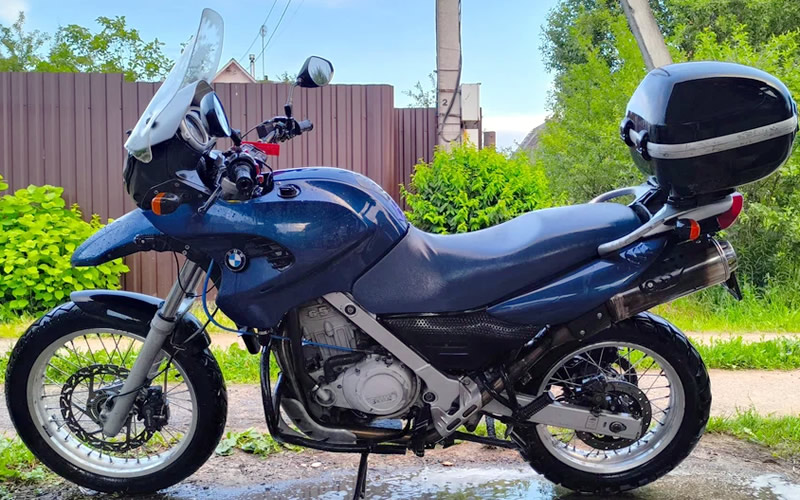
F650GS 2003 year, left view
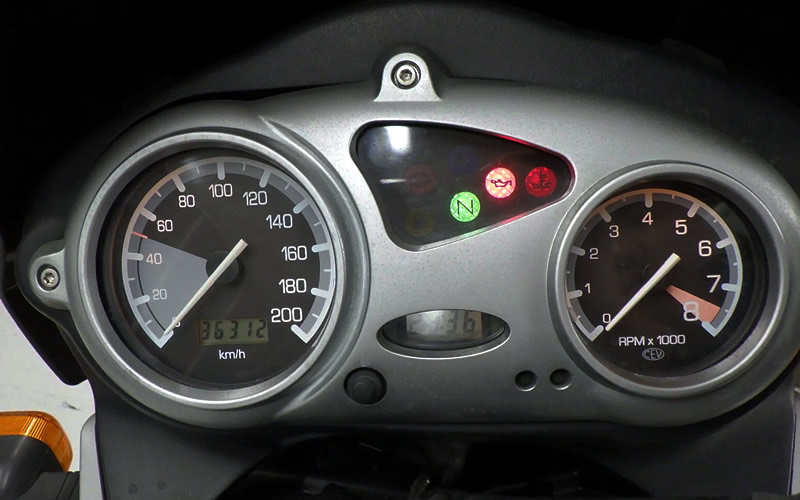
F650GS 2001 year, dashboard
F 650 GS Dakar (2000-2007)
Following the success in the Dakar Rally, BMW released a Dakar version alongside the F 650 GS. This model featured more aggressive off-road tires, longer suspension travel, hand guards, and a higher seat height. Both the GS and the Dakar version were succeeded in 2008 by the 800cc twin-cylinder models: the F 650 GS, which indeed had an 800cc engine, and the F 800 GS.
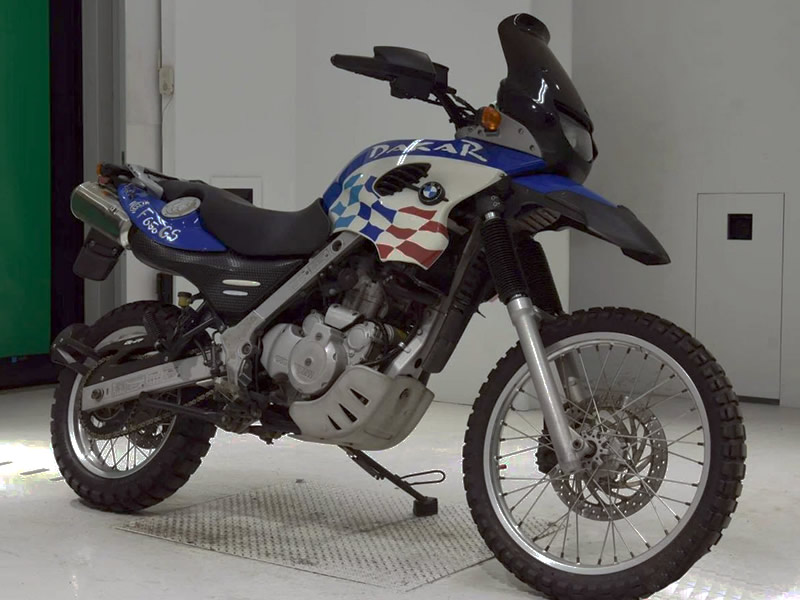
F650GS Dakar 2002 year, front view
F 650 CS (2001-2007)
The F 650 CS (City Scarver) was launched in August 2001 as the successor to the street-focused F 650 ST. The CS was more than just an upgraded model; it was largely redesigned. While the engine was largely based on that of the F 650 GS, a modification in the airbox resulted in slightly increased torque. The most significant technical change was the belt drive to the rear wheel. Similar to the GS, the tank was located under the seat, with the dummy tank housing the airbox and battery. The frame was revamped, and the design was modern. It featured three-spoke cast wheels unique to this model. The dummy tank included a space for storing a tank bag, with attachment points for a special tank bag or a lockable strap for helmet storage or an audio system with two speakers. The swingarm was replaced with a single-sided rear suspension. The monoshock used a link system.
All body panels were interchangeable, allowing customers to change the bike's color. Standard equipment included a tank bag and luggage rack, capable of holding two bags that could be zipped together to form a backpack. An under-cowl was available as an extra. Additional accessories included a board computer, anti-theft system, 12-volt socket, cover, ABS, and heated grips. BMW also launched a complete clothing line for CS riders.
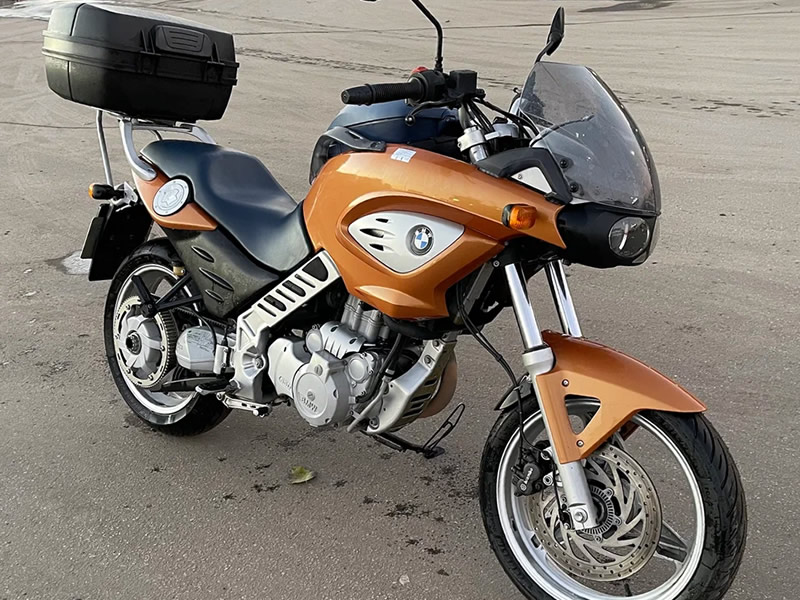
F650CS 2002 year, front view
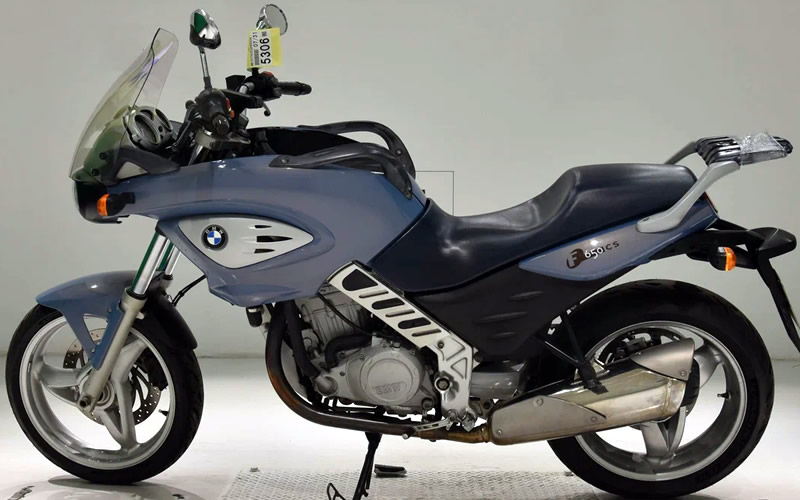
F650CS 2003 year, left view
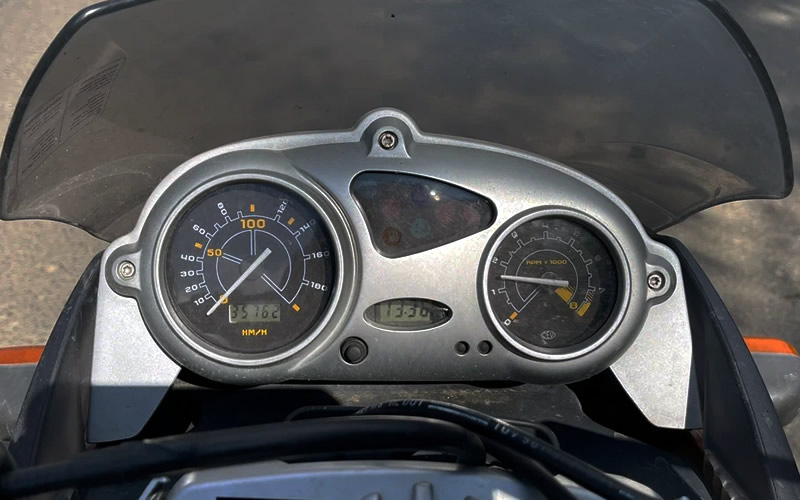
F650CS 2004 year, dashboard
F 650 CS 80th Anniversary Limited Edition
In 2003, BMW Motorrad celebrated its 80th anniversary. To mark the occasion, three "Limited Editions" were released: the F 650 CS, the R 1150 R Rockster 80th Anniversary Limited Edition, and the K 1200 LT 80th Anniversary Limited Edition. Fifty units of the F 650 CS were made available in the Netherlands. They were delivered with a scale model, an MP3 player, the BMW audio system with active speakers and helmet connection, a certificate, and a plaque. There were no technical changes compared to the standard F 650 CS.
Technical data F650
| F 650 | F 650 ST | F 650 RR | F 650 GS | F 650 GS Dakar | F 650 CS | |
| Period | 1993-2000 | 1996-2000 | 1999 | 2000-2007 | 2001-2007 | |
| Production quantity | 51,405 | 12,934 | unknown | |||
| Category | allroad | touring motorcycle | enduro motorcycle | allroad | touring motorcycle | |
| Engine type | overhead valve engine | |||||
| Construction method | transversely mounted single cylinder | |||||
| boring | 100 mm | |||||
| blow | 83 mm | |||||
| Cylinder capacity | 652 cc | |||||
| Max. Power | 35 kW/48 hp | 55 kW/75 hp | 37 kW/50 hp | |||
| Top speed | 163 km/h | unknown | 166 km/h | 175 km/h | ||
| Drive | chain, CS belt drive | |||||
| Bicycle part | single cradle frame | |||||
| Empty weight | 191 kg | 191 kg | 168 kg (dry weight) | 177 kg | 187 kg | |
| Max. total weight | 371 kg | unknown | 380 kg | 370 kg | ||
| Tank capacity | 17.5 liters | 45 liter | 17.5 liters | 17.5 liters | 15 liter | |
BMW F 800 Series (2006-2020)
The F 800 Series is a range of motorcycles from the BMW brand. This series consisted of five models, all equipped with an 800cc vertical twin engine, including the F 650 GS, which, despite its name, also had an 800cc engine.
With the discontinuation of most F 650 models and the R 850 series around 2005, only relatively heavy BMW motorcycles were available. There was a significant gap between the remaining F 650 CS and the 1200cc R series and K series. The R 850 series still consisted of rather expensive motorcycles, as they were assembled from the same components as the R 1100 series due to the modular production system. While cost-effective, the concept, especially the shaft drive, made it quite expensive. By 2006, only the R 850 R Comfort from the R 850 series was still available. BMW needed models in the affordable mid-range segment. In 2001, a team of 25 engineers and designers began the project to develop the new models. Rumors of BMW working on these new models started circulating in the summer of 2005. There were even talks of an 800cc three-cylinder engine developed in collaboration with Rotax. However, the first spy photos in September 2005 revealed a liquid-cooled twin-cylinder.
In 2006, BMW introduced a completely new line of motorcycles featuring a transversely-mounted 800cc parallel-twin developed in collaboration with Rotax. Unlike the BMW F 650 series, this was not a modified existing Rotax engine but a specifically developed engine for this series of motorcycles. The F 800 Series aimed to cater to customers seeking a mid-range motorcycle. Following the F 650's lead, all models had the fuel tank under the seat. The airbox was located where the tank would typically be expected, with the battery mounted just behind the headstock.
Engine
The engine was developed in collaboration with Rotax and was initially produced there until 2008. From 2008, production moved to the Loncin Motor Company in Chongqing, China. It was a four-stroke parallel-twin with dual overhead camshafts and four valves per cylinder. The 360° twin had a four-bearing crankshaft and an additional connecting rod between the two cylinders. This connecting rod was positioned 180° from the other two and connected with a lever. This lever pivoted under the gearbox to balance the vertical twin, a concept similar to the additional connecting rod Ducati once used on the Ducati Supermono. Fuel injection and a regulated three-way catalytic converter were employed. Fuel injection was managed by the BMS-K engine management system, except for the F 800 R, which received the BMS-KP system also used on the S 1000 RR. Many motorcycle journalists found the sound remarkably similar to that of boxer engines, which was not surprising as both the boxer and the twin ignited the fuel mixture at 360° and "ran" identically. A dry sump lubrication system was used, with a rev limiter kicking in at 9,000 rpm. Over time, many adjustments were made, including a new water pump due to frequent leaks, modifications to the alternator coils, reinforcement of the transmission dampers and gear attachment on the rear axle. A ping sensor was later installed, as the initial batch with gray engine blocks had piston tilting issues leading to many engine replacements.
Frame
The first two models, the "S" and the "ST," featured an aluminum bridge frame primarily consisting of two box-section beams. The F 800 R, derived from the "S," also used this frame. The GS models had a steel trellis frame where the engine acted as a structural component. In the GS models, the engine was slightly tilted backward to allow for a longer swingarm. A paralever construction was unnecessary as the belt drive did not induce cardan reaction forces.
Drivetrain
All models had a six-speed gearbox. The "S" and "ST" models, like the F 650 CS, used belt drive. The GS models had chain drive due to the risk of belt damage from stones. The F 800 R was also equipped with chain drive.
Wheels and Suspension
To save costs and maintain the wheelbase, the F 800 Series did not feature a telelever front fork but a telescopic fork instead. At the rear, a single-sided swingarm was employed, with a beautifully shaped rear frame. The rear shock absorber's preload could be adjusted with a twist knob.
Brakes
All models were equipped with disc brakes, with one or two discs in the front wheel depending on the model. ABS was available as an option.
F 800 S (2006-2010)
The F 800 S was the first model released, simultaneously with the ST. It was the sporty model of the series, featuring a half fairing, aluminum cast wheels, and two disc brakes in the front wheel. As an option, the bike could be equipped with ABS, Tire Pressure Control, an onboard computer, white turn signals, heated grips, theft alarm, lowered suspension, center stand, luggage rack, luggage set, and a lowered seat. The width of the luggage could be adjusted. From 2009, both the "S" and the "ST" models had black-painted engine blocks. If ABS was installed, it included a lift sensor for the rear wheel, a feature also seen on the HP2 Sport, ensuring ABS engagement in cases of dynamic weight transfer. The standard dashboard display included a speedometer, tachometer, two trip meters, a clock, coolant temperature, and a fuel gauge. The optional onboard computer added average speed, average fuel consumption, current fuel consumption, and outside temperature.
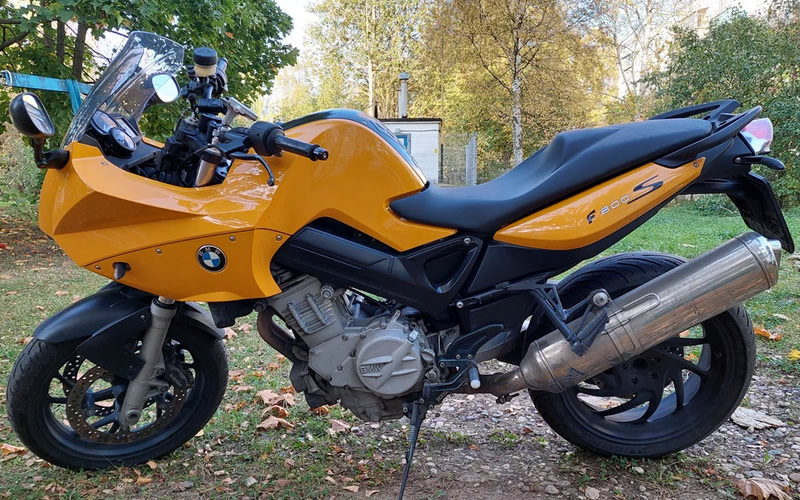
F800S 2007 year, left view
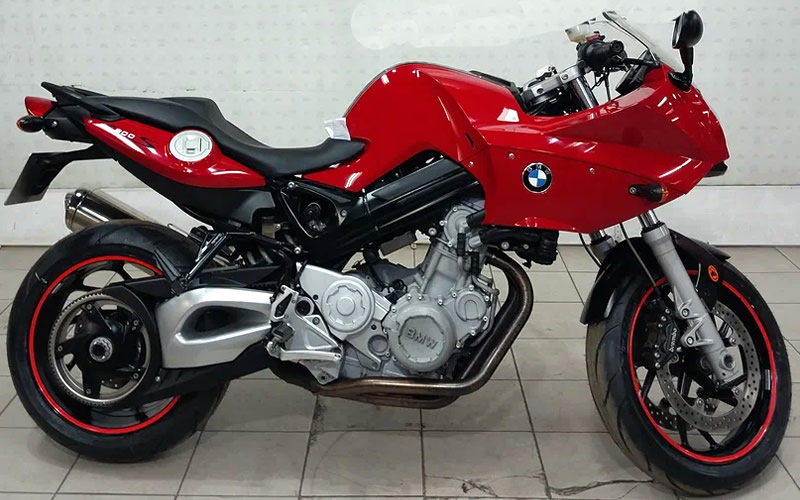
F800S 2008 year, right view

F800S 2009 year, dashboard
F 800 ST (2006-2012)
The F 800 ST was nearly identical to the "S," with the main difference being the full touring fairing and a higher handlebar instead of the lower clip-ons.
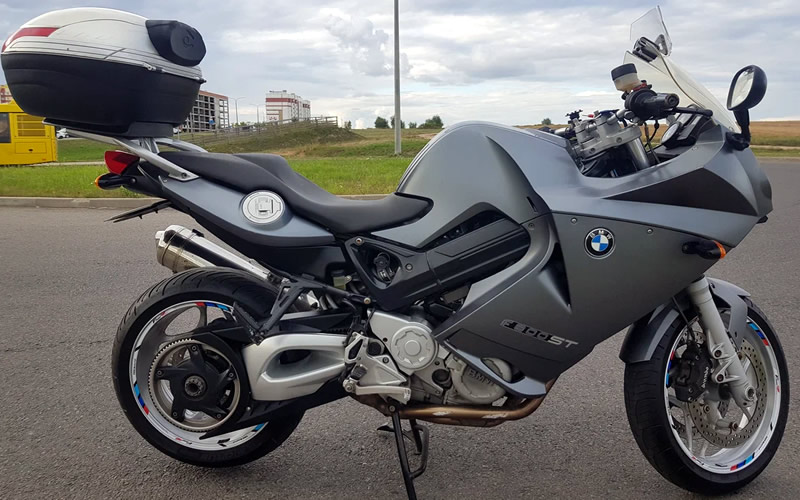
F800ST 2007 year, right view
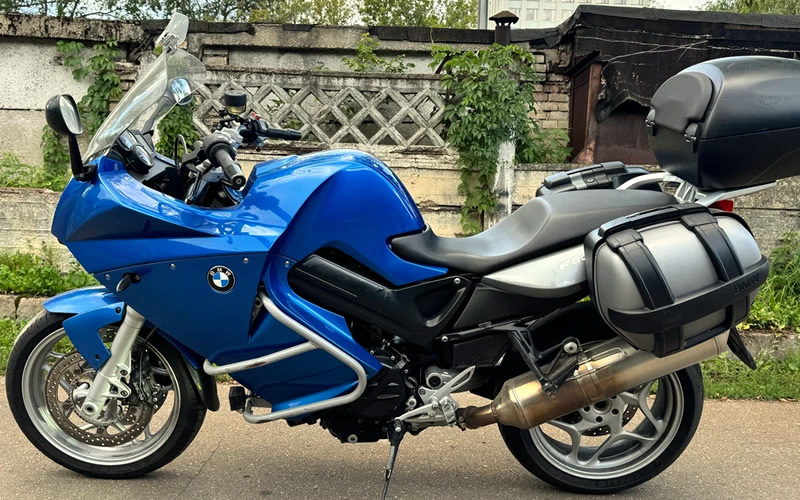
F800ST 2012 year, left view
F 800 Sport Edition (2007)
The F 800 Sport Edition was released in the summer of 2007. This special version of the F 800 S was painted in Titansilber/Cosmicblue, had white turn signals, a tinted windshield, an Akrapovic sport exhaust, an onboard computer, and Teil Integral ABS.
F 800 GS (2008-2012)
The F 800 GS and the F 650 GS were introduced alongside the G 450 X at the EICMA in Milan in November 2007. The machine bore a strong resemblance to its larger sibling, the R 1200 GS, but incorporated most components from the F 800 series. It featured the same 85 hp 800cc engine but with a new lattice frame. The single-sided rear suspension was replaced with a standard swingarm. Cross-spoke wheels with black rims, 21 inches in the front and 17 inches in the rear, indicated its off-road capabilities. ABS was available as an option. In 2012, the model underwent revisions coinciding with the launch of the F 700 GS.
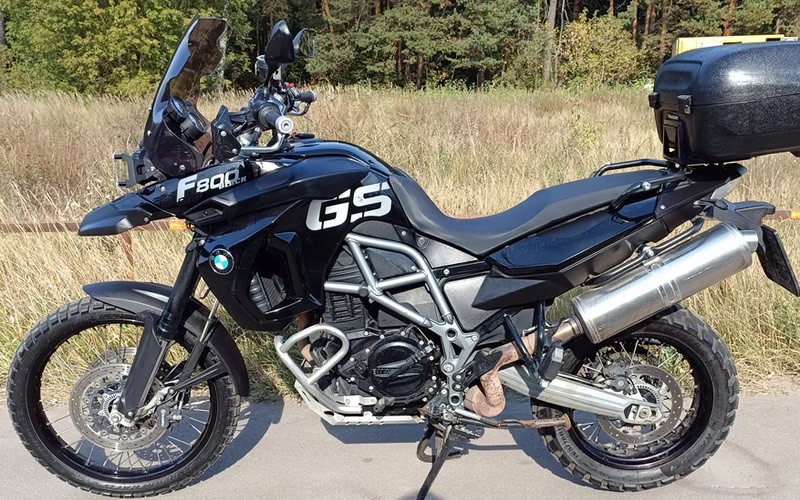
F800GS 2011 year, left view
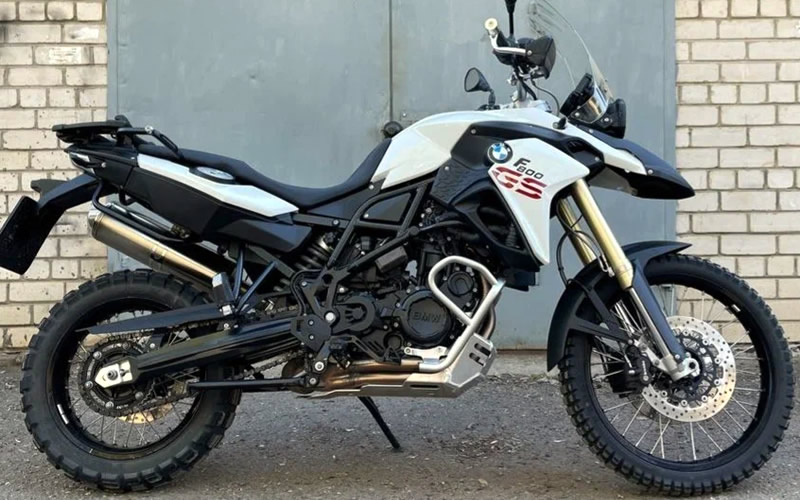
F800GS 2013 year, right view
F 650 GS (2008-2012)
The F 650 GS had a confusing model name, identical to the F 650 GS single-cylinder, but it housed the same 800cc twin-cylinder engine found in the entire F 800 series. It was designed more for road use, featuring cast wheels, and the engine was detuned to deliver 71 hp and 75 Nm of torque. The windscreen was slightly lower than that of the F 800 GS. A 25 kW version was available for novice riders. The bike could be equipped with a complete luggage set, including a top case and tank bag. The 650 had only one front disc brake and could be fitted with ABS. Due to the 17" front wheel and shorter suspension travel, it sat lower than the F 800 GS.
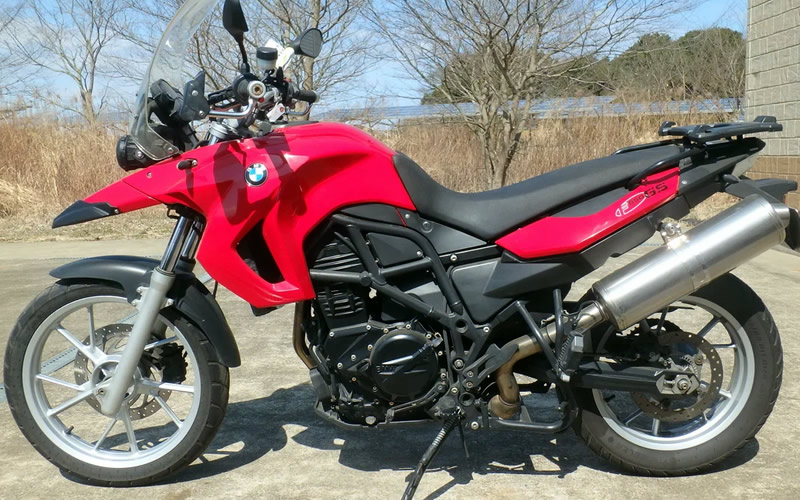
F650GS 2008 year, left view
F 800 R (2009-2019)
The F 800 R was introduced in 2009, offering a slightly more powerful 87 hp compared to the rest of the series. It was a naked bike inspired by the stripped-down F 800 S used by stunt rider Chris Pfeiffer. The bike featured the aluminum bridge frame from the S and ST models, with the rear swingarm and chain drive from the GS models. It sported a wide (180 mm) rear tire, a conventional non-adjustable 43 mm telescopic fork, two front disc brakes with four-piston calipers, and a single rear disc with a twin-piston caliper. The asymmetrical headlight borrowed from the F 800 GS was a standout feature. The gearing, particularly in the top three gears, was shorter than the S and ST models, making the bike high-revving for highway use. The dashboard included a speedometer, two trip meters, a tachometer, a fuel gauge, a clock, and a temperature gauge. The optional onboard computer provided average speed, consumption statistics, and range information. ABS was available as an option, along with heated grips, LED turn signals, an alarm, and a color-matched windscreen.
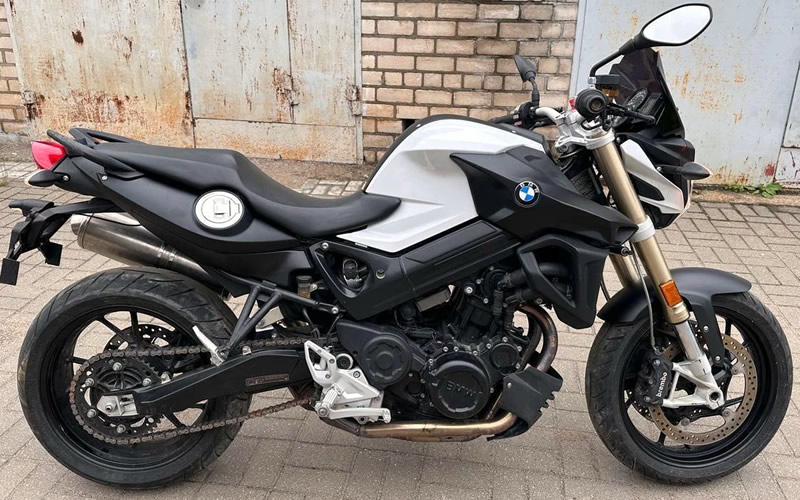
F800R 2016 year, right view
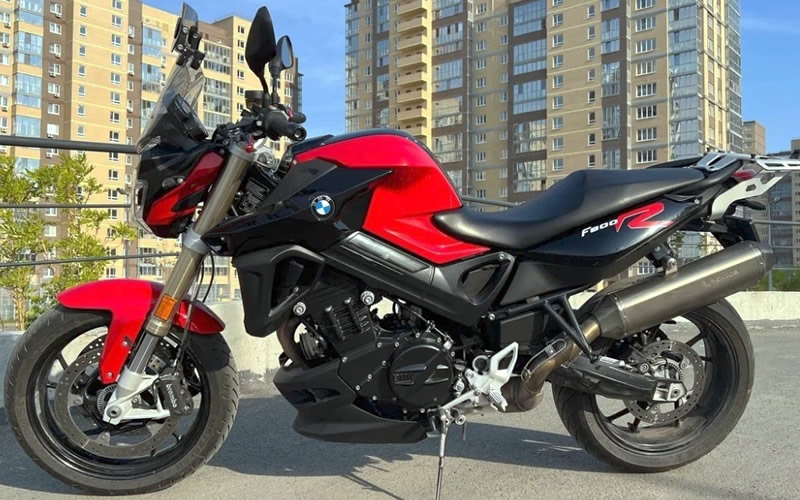
F800R 2018 year, left view
F 800 R Chris Pfeiffer Replica (2009)
During the EICMA exhibition in Milan in December 2008, a replica of BMW stunt rider Chris Pfeiffer's bike was showcased as a concept bike. The F 800 R was not yet available for purchase at the time. When Pfeiffer won his fourth stunt riding world championship in 2009, the bike was released to the market. The "original" machine used by Pfeiffer for stunts was a bare F 800 S, equipped with a belt drive. Both the F 800 R and the Chris Pfeiffer Replica adopted the chain drive from the GS models. The Replica was painted in the same BMW Motorsport colors as Pfeiffer's stunt bike, including sponsor stickers. The belly pan was omitted, and the Replica differed from the standard F 800 R with a white front wheel, duo seat cover, absence of a windshield, red rear spring, and an Akrapovic exhaust. ABS was standard, but it limited extreme stunts as it intervened during stoppies due to the dynamic weight transfer.
F 700 GS (2011-2017)
The F 650 GS was succeeded in 2012 by an upgraded version, the F 700 GS. This model saw an increase in power to 75 hp, with a 47.5 hp version available for A2 license holders introduced in 2012. The design was enhanced, and a second front disc brake was added. ABS was standard on all models from 2012, with ASC and ESA available as options. The bike could be equipped with a lowering kit.
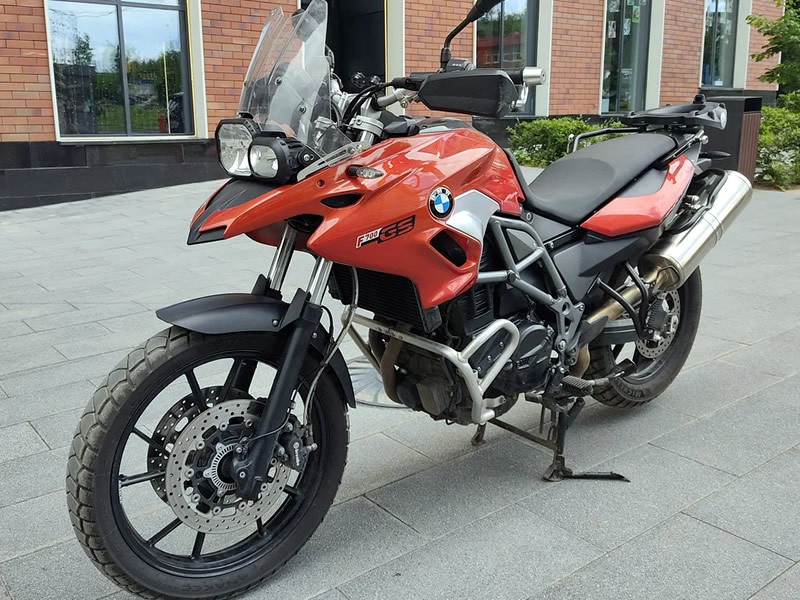
F700GS 2017 year, front view

F700GS 2016 year, right view
F 800 GT (2013-2020)
In November 2012, the F 800 GT was introduced as the successor to the less successful F 800 ST. The GT featured a full touring fairing with a low windshield and fixed hardshell panniers (unlike the other models with variable panniers). ABS was standard, with Automatic Stability Control (ASC) and Electronic Suspension Adjustment (ESA) available as options. The engine delivered 90 hp at 8,000 rpm, with a 50mm longer swingarm for improved stability and 15mm shorter suspension travel.
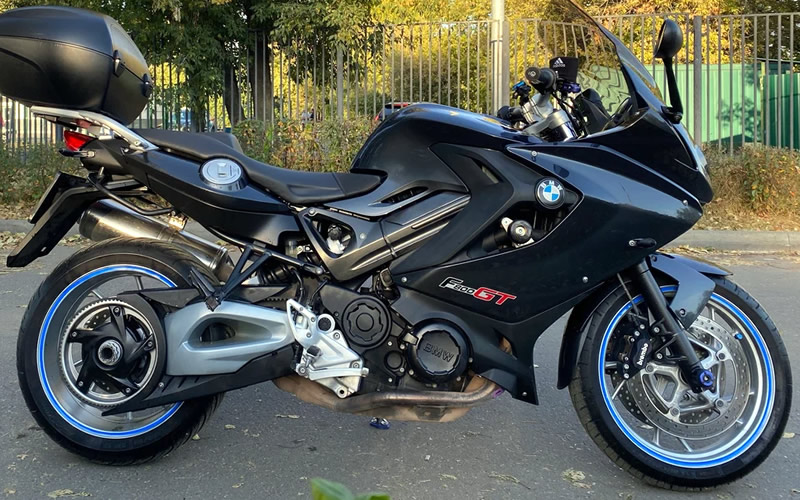
F800GT 2014 year, right view

F800GT 2013 year, left view
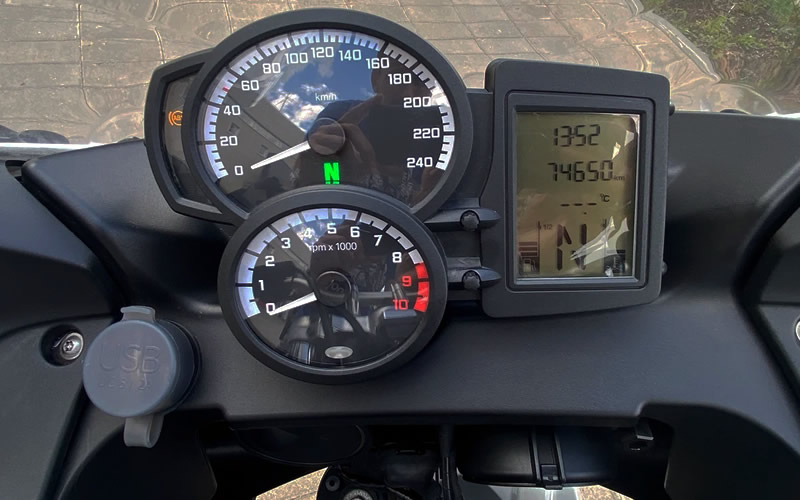
F800GT 2015 year, dashboard
F 750 GS (2018-2024)
The BMW F 750 GS is a motorcycle produced by the German motorcycle manufacturer BMW Motorrad. Produced from 2018 to 2024, the F 750 GS is designed to offer a perfect balance of performance, versatility, and comfort, making it an ideal choice for both on-road and off-road travel.
Powered by an 853cc inline twin-cylinder engine, capable of delivering a maximum power of 77 hp (57 kW) at 7500 rpm and a maximum torque of 83 Nm at 6000 rpm. Developed in collaboration with the Chinese motorcycle manufacturer Loncin, this engine features liquid cooling, four valves per cylinder, and dry sump lubrication. These features not only ensure reliability and performance but also compliance with strict Euro 5 emission regulations.
This engine is also shared with its siblings, the F 850 GS and F 850 GS Adventure, but in the F 750 GS, the ECU has been detuned.

F750GS 2019 year, left view
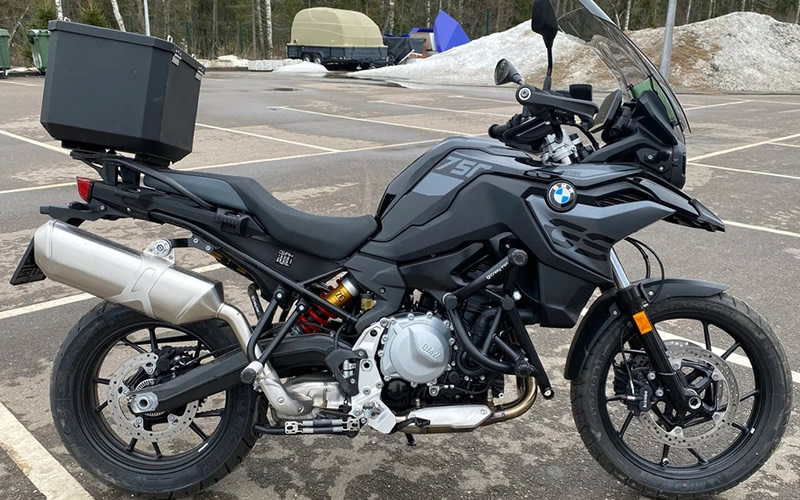
F750GS 2022 year, right view
F 850 GS (2018-2024)
The BMW F 850 GS is a motorcycle produced by BMW Motorrad from 2018 to 2024, falling into the category of adventure touring bikes.
Unveiled at EICMA in November 2017, the bike is powered by an 853cc engine producing 95 hp and is positioned below the BMW R1250 GS, distinguished by a different engine (inline twin-cylinder in this case, opposed twin in the R1250) and transmission (chain-drive, as opposed to shaft-drive in the R1250).
Designed for more versatile use, the F 850 GS is suitable for off-road riding with its 21-inch spoked front wheel. The engine, instead of being produced by Rotax as in the previous F800, is manufactured in China by Loncin and is similar to the engines in the BMW F900 XR and F900 R, albeit with lower displacement and power.
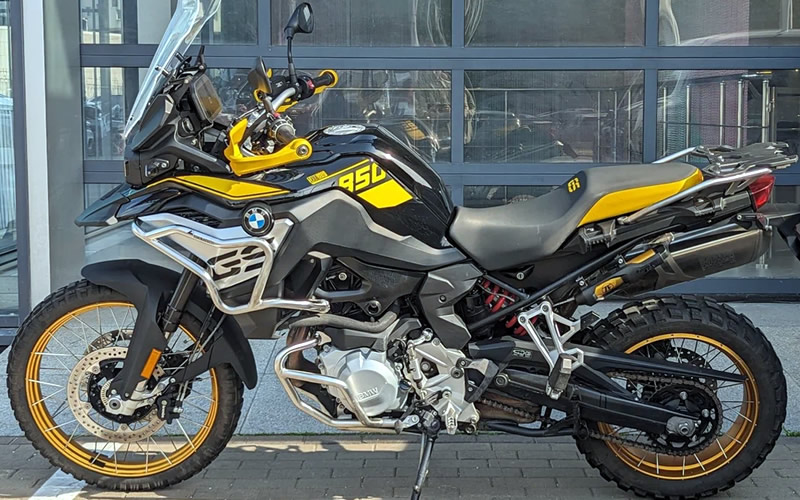
F850GS 2020 year, left view
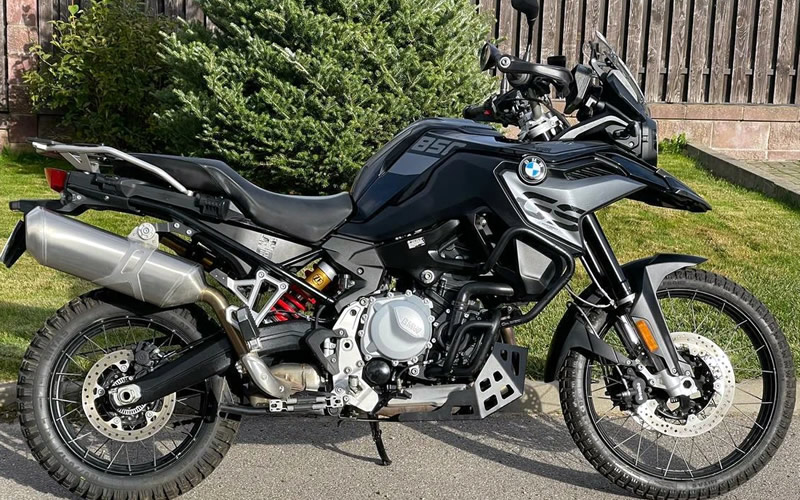
F850GS 2022 year, right view
F 900 R / F 900 XR (2019-current)
The BMW F 900 R is an unfaired motorcycle from the German vehicle manufacturer BMW. The naked bike has been produced in Berlin since 2020. In addition, there is the more comfortable F 900 XR (XR stands for "Crossover") with a small front fairing and longer suspension travel.
The F-900 machines feature LED lighting and a 6.5-inch TFT display introduced in the R 1250 GS in 2017 and supplied by Bosch.
The cylinders of the liquid-cooled inline twin-cylinder engine have a bore diameter of 86 mm and a piston stroke of 77 mm. Compared to its predecessor, the cylinder heads have been revised and the pistons are now forged instead of cast. The compression ratio is now 13.1:1. Without reducing power, the 895cc engine produces a rated power of 77 kW (105 hp) at 8500 rpm and a maximum torque of 92 Nm at 6500 rpm. The crankpins are offset by 90°, so the firing order is that of a 90° V-twin engine. To minimize noise and vibrations, the engine has counter-rotating balance shafts. The engine is manufactured by Loncin in China.
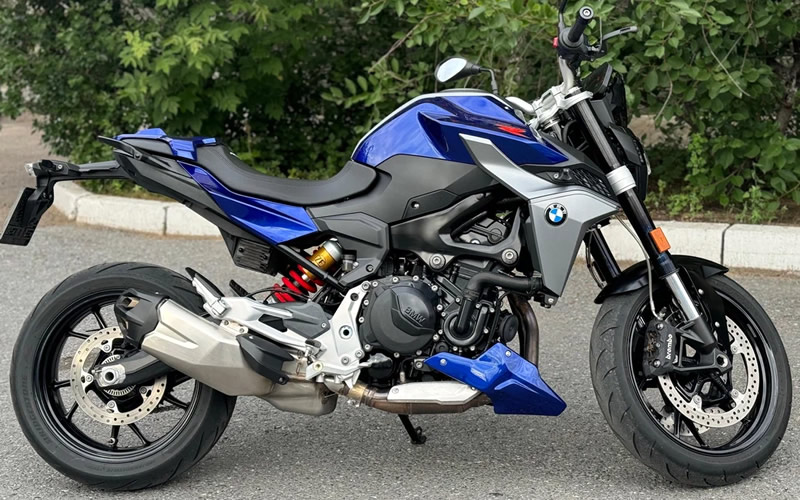
F900R 2020 year, right view
The motorcycle accelerates from 0 to 100 km/h in less than four seconds and reaches a top speed of 216 km/h. In practice, fuel consumption is at least 5.0 l/100 km. For riders with an A2 license, a motor with a power output limited to 35 kW (48 hp) at 6500 rpm is available, with an unrestricted power of 70 kW (95 hp).
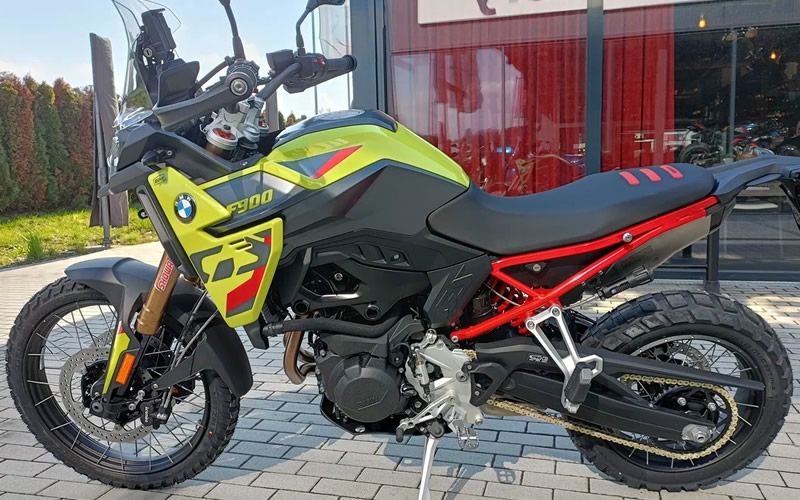
F900R 2024 year, left view
The frame is based on a steel bridge frame. Unlike the F800 machines, the tank is no longer located under the seat but is made of plastic. The front wheel is guided by a telescopic fork with a 43 mm diameter and 135 mm of travel (900 XR 170 mm). The cast aluminum double-sided swingarm has a directly linked shock absorber with 142 mm of travel (900 XR 172 mm). The machine can have 20 mm shorter suspension travel upon request. Additionally, the dynamic ESA (Electronic Suspension Adjustment) is available, which works with other systems like ABS or the optional cornering ABS (ABS Pro) and adjusts the damping of the rear shock absorber. The suspension tuning between the R and XR models is different due to triple clamp offset, shock linkage, and seat design. Standard riding modes "Rain" and "Road" are selectable, with additional options available, and the automatic stability control ASC can be turned off.
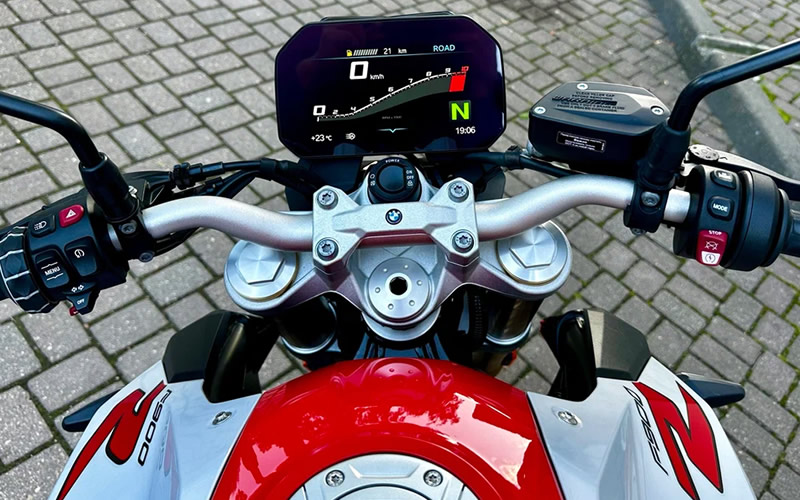
F900R 2021 year, dashboard
The curb weight is 211 kg (DIN curb weight, ready to ride with 90% fuel and standard equipment), the maximum payload is 219 kg, and the permissible total weight is 430 kg.
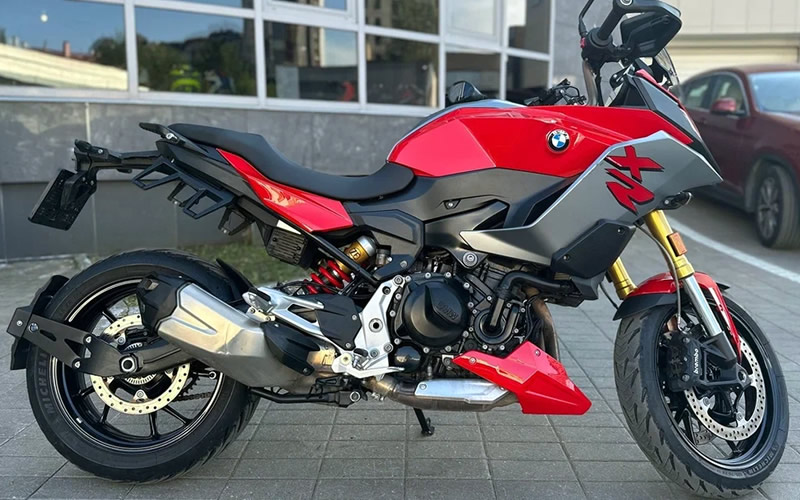
F900XR 2022 year, right view
Technical data F800
| F 800 S | F 800 ST | F 800 Sport Edition | F 800 GS | F 800 GS | F 650 GS | F 700 GS | F 800 R | F 800 R Chris Overmeire Replica | F 800 GT | |
| Period | 2006-2010 | 2006-2012 | 2007 | 2008-2012 | 2012 | 2008-2012 | 2012 | 2009-2019 | 2009 | 2013-2020 |
| Category | sports motorcycle | sports tourer | sports motorcycle | allroad | naked bike | touring motorcycle | ||||
| Engine type | two-cylinder DOHC engine with four valves per cylinder and fuel injection | |||||||||
| Construction method | transversely mounted parallel twin | |||||||||
| boring | 82 mm | |||||||||
| stroke | 75.6 mm | |||||||||
| Engine displacement | 798 cc | |||||||||
| Max. Power | 63.5 kW/85 hp at 8,000 rpm (claimed) 66 kW/90 hp at 8,400 rpm (measured) | 53 kW/71 hp at 7,000 rpm | 55 kW/75 hp at 7,300 rpm | 64 kW/87 hp at 8,000 rpm | 66 kW/90 hp at 8,000 rpm | |||||
| Max. Torque | 85 Nm at 5,800 rpm | 83 Nm at 5,750 rpm | 75 Nm at 4,500 rpm | 77 Nm at 5,500 rpm | 86 Nm at 6,000 rpm | follows | ||||
| Top speed | 224 km/h | 224 km/h | 204 km/h | ≥200km/h | 185 km/h | 192 km/h | 223 km/h | follows | ||
| Dry weight | 182 kg | 182 kg | 185 kg | 191 kg | 179 kg | 186 kg | 179 kg | follows | ||
| Curb weight | 210 kg | 204 kg | 207 kg | 214 kg | 199 kg | 209 kg | 199 kg | follows | ||
| Tank capacity | 16 liter | |||||||||
| Frame | aluminum bridge frame | steel truss frame | aluminum bridge frame | |||||||
| Drive | timing belt drive | chain drive | timing belt drive | |||||||
- Information for owner
- Introduction to manual
- Maintenance
- Engine and systems
- Engine repair
- Ignition system
- Fuel and exhaust systems
- Cooling system
- Transmission
- Running gear and frame
- Frame and hinged elements
- Handlebar
- Rear suspension
- Brake system
- Wheels and tires
- Electric equipment
- Equipment and devices
- Lighting and lamps
Aprilia: RS-series Shiver (map) BMW: F-series R-series K-series (map) Ducati: ST series Monster (map) Harley: Street Sportster V-Rod (map) Honda: Africa Twin CB series VTX series (map) Kawasaki: ZX-6R Versys Vulcan (map) Suzuki: DR-Z V-Strom Boulevard (map) Triumph: Rocket Street Triple Tiger (map) Yamaha: Fazer DragStar R1 (map)
